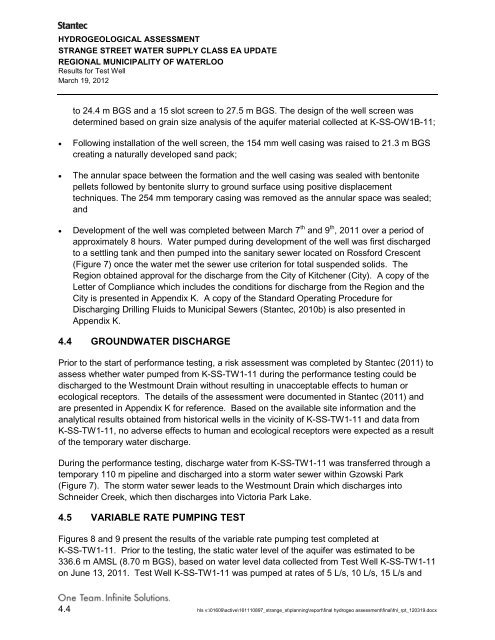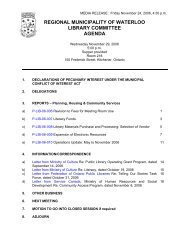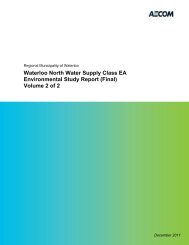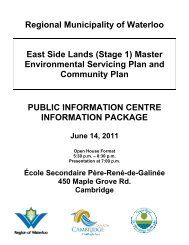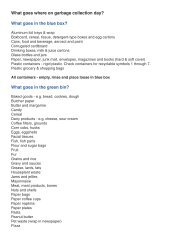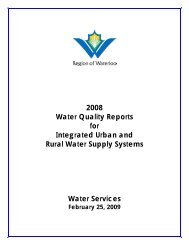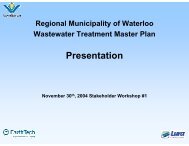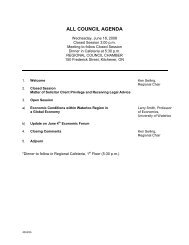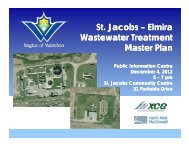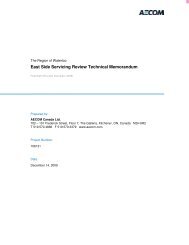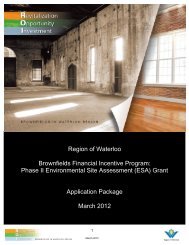Sam Ziemann From - Region of Waterloo
Sam Ziemann From - Region of Waterloo
Sam Ziemann From - Region of Waterloo
You also want an ePaper? Increase the reach of your titles
YUMPU automatically turns print PDFs into web optimized ePapers that Google loves.
HYDROGEOLOGICAL ASSESSMENTSTRANGE STREET WATER SUPPLY CLASS EA UPDATEREGIONAL MUNICIPALITY OF WATERLOOResults for Test WellMarch 19, 2012to 24.4 m BGS and a 15 slot screen to 27.5 m BGS. The design <strong>of</strong> the well screen wasdetermined based on grain size analysis <strong>of</strong> the aquifer material collected at K-SS-OW1B-11;• Following installation <strong>of</strong> the well screen, the 154 mm well casing was raised to 21.3 m BGScreating a naturally developed sand pack;• The annular space between the formation and the well casing was sealed with bentonitepellets followed by bentonite slurry to ground surface using positive displacementtechniques. The 254 mm temporary casing was removed as the annular space was sealed;and• Development <strong>of</strong> the well was completed between March 7 th and 9 th , 2011 over a period <strong>of</strong>approximately 8 hours. Water pumped during development <strong>of</strong> the well was first dischargedto a settling tank and then pumped into the sanitary sewer located on Rossford Crescent(Figure 7) once the water met the sewer use criterion for total suspended solids. The<strong>Region</strong> obtained approval for the discharge from the City <strong>of</strong> Kitchener (City). A copy <strong>of</strong> theLetter <strong>of</strong> Compliance which includes the conditions for discharge from the <strong>Region</strong> and theCity is presented in Appendix K. A copy <strong>of</strong> the Standard Operating Procedure forDischarging Drilling Fluids to Municipal Sewers (Stantec, 2010b) is also presented inAppendix K.4.4 GROUNDWATER DISCHARGEPrior to the start <strong>of</strong> performance testing, a risk assessment was completed by Stantec (2011) toassess whether water pumped from K-SS-TW1-11 during the performance testing could bedischarged to the Westmount Drain without resulting in unacceptable effects to human orecological receptors. The details <strong>of</strong> the assessment were documented in Stantec (2011) andare presented in Appendix K for reference. Based on the available site information and theanalytical results obtained from historical wells in the vicinity <strong>of</strong> K-SS-TW1-11 and data fromK-SS-TW1-11, no adverse effects to human and ecological receptors were expected as a result<strong>of</strong> the temporary water discharge.During the performance testing, discharge water from K-SS-TW1-11 was transferred through atemporary 110 m pipeline and discharged into a storm water sewer within Gzowski Park(Figure 7). The storm water sewer leads to the Westmount Drain which discharges intoSchneider Creek, which then discharges into Victoria Park Lake.4.5 VARIABLE RATE PUMPING TESTFigures 8 and 9 present the results <strong>of</strong> the variable rate pumping test completed atK-SS-TW1-11. Prior to the testing, the static water level <strong>of</strong> the aquifer was estimated to be336.6 m AMSL (8.70 m BGS), based on water level data collected from Test Well K-SS-TW1-11on June 13, 2011. Test Well K-SS-TW1-11 was pumped at rates <strong>of</strong> 5 L/s, 10 L/s, 15 L/s and4.4 hls v:\01609\active\161110897_strange_st\planning\report\final hydrogeo assessment\final\fnl_rpt_120319.docx


